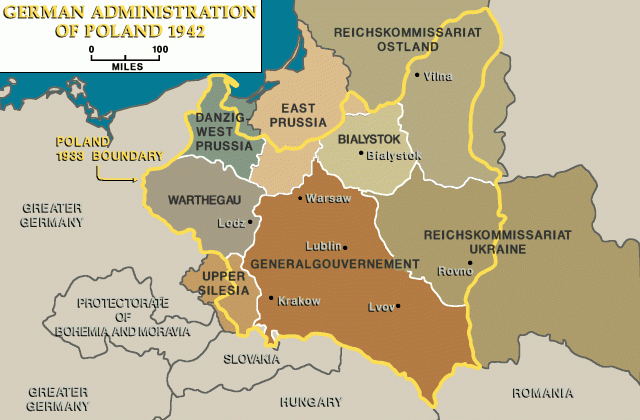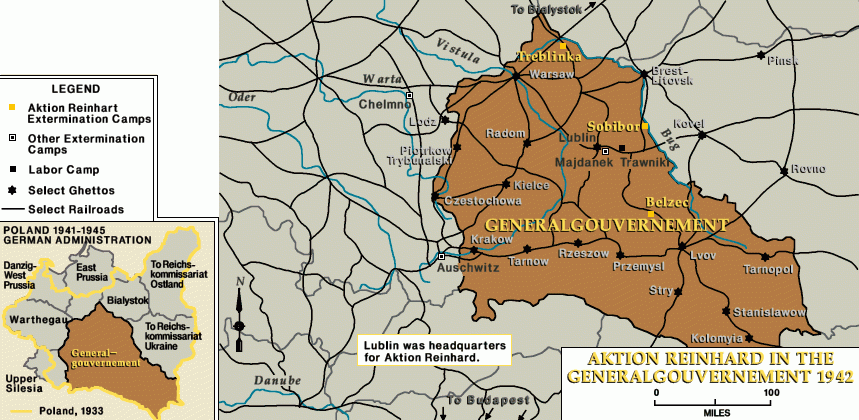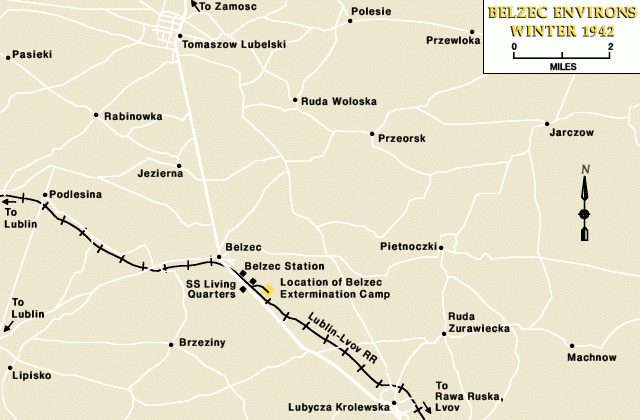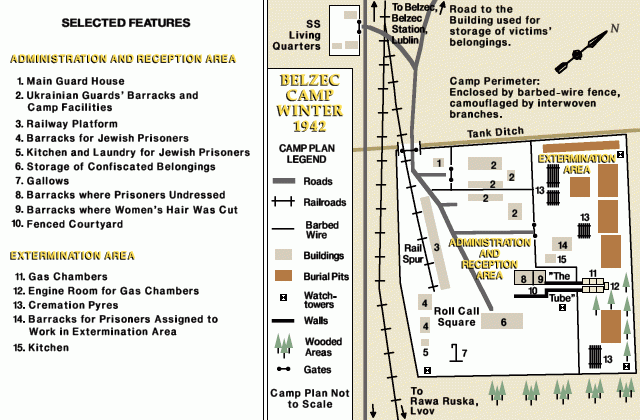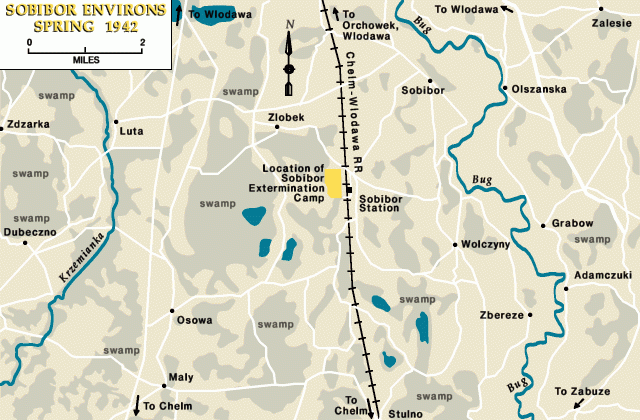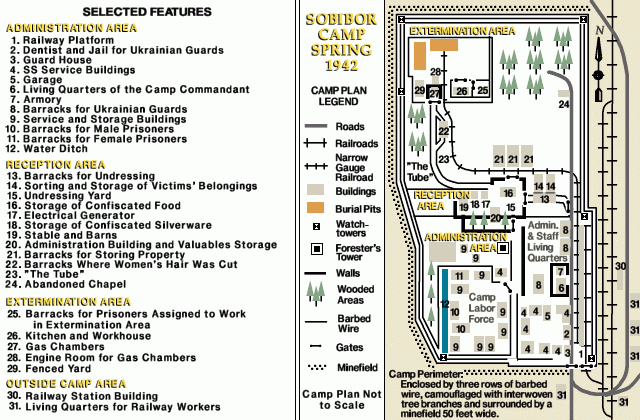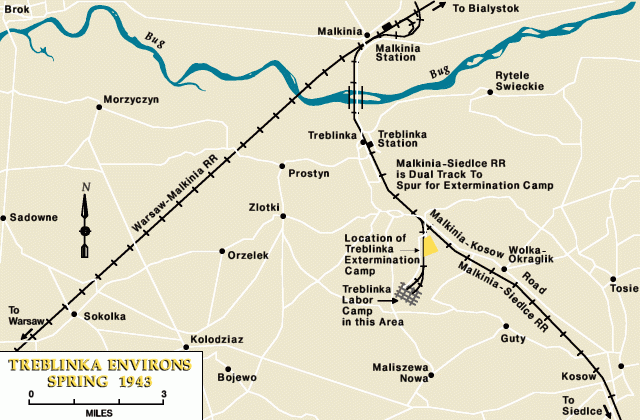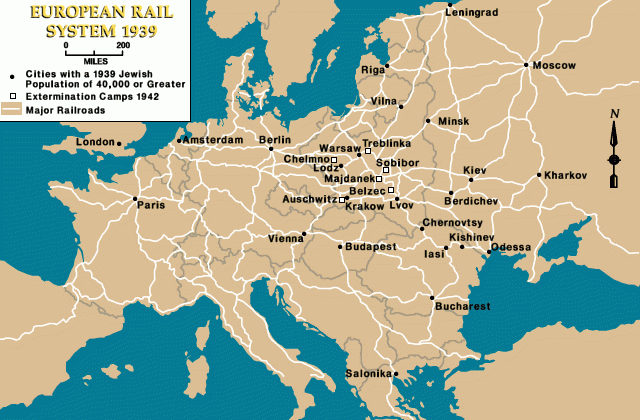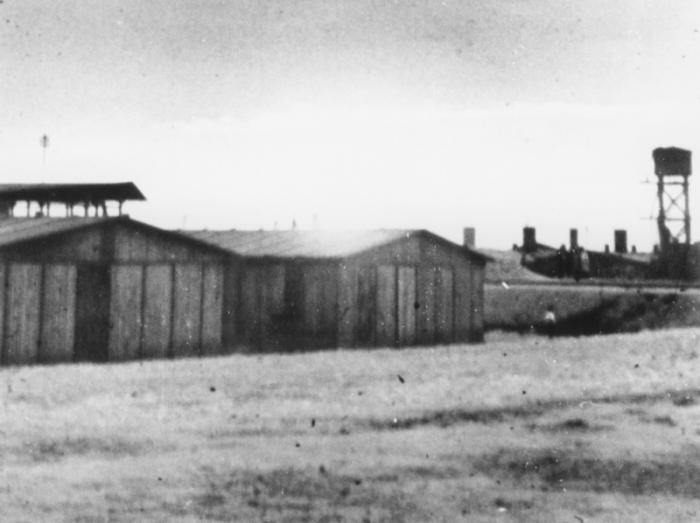
Trawniki
The SS camp at Trawniki in the Lublin District of the General Government existed from July 1941 through July 1944. It underwent four changes of function and purpose in the three years of its existence.
Purpose of the Trawniki Camp
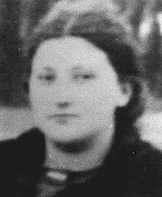
From July until September 1941, Trawniki served as a holding pen for Soviet civilians and soldiers. From September 1941 until July 1944, it was a training facility for police auxiliaries deployed in Operation Reinhard. From June 1942 until September 1943, it served as a forced-labor camp for Jews within the framework of Operation Reinhard. Between September 1943 and May 1944 it was a subcamp of the Lublin/Majdanek concentration camp.
Establishment of the Trawniki Camp
Nazi Germany invaded the Soviet Union on June 22, 1941. Less than two weeks later, German SS and police authorities in the Lublin district established a detention facility on the grounds of an abandoned sugar refinery outside of Trawniki (a town located just south of the Lublin-Chelm road, 20 miles east southeast of Lublin and about the same distance due east of Chelm). They were acting on the orders of the SS and Police Leader (SS- und Polizeiführer; SSPF) for Lublin District, SS Major General Odilo Globocnik.
Managed by an officer on Globocnik's staff, SS Captain Hermann Höfle, the Trawniki camp originally was a holding center for refugees and Soviet prisoners of war (POWs), whom the Security Police and SD had designated either potential collaborators or dangerous persons. On July 9, 1941, 676 inmates were incarcerated there.
In September 1941, pursuant to his July 17, 1941, appointment as Commissioner for the Establishment of SS and Police Bases (SS- und Polizeistutzpünkte) in the New Eastern Territory, Globocnik transformed the facility into a training camp for auxiliary police personnel to maintain security for proposed German settlements in the occupied Soviet Union. Globocnik's staff recruited as auxiliaries captured Soviet soldiers, who, after being processed in Trawniki, entered the Guard Forces (Wachmannschaften) of the SSPF in the Lublin District. The first Soviet soldiers recruited from the prisoner-of-war camps arrived at Trawniki in early September 1941.
On October 27, 1941, Globocnik appointed SS Captain Karl Streibel to command the newly christened Trawniki training camp, a position Streibel held until the evacuation of the camp in July 1944.
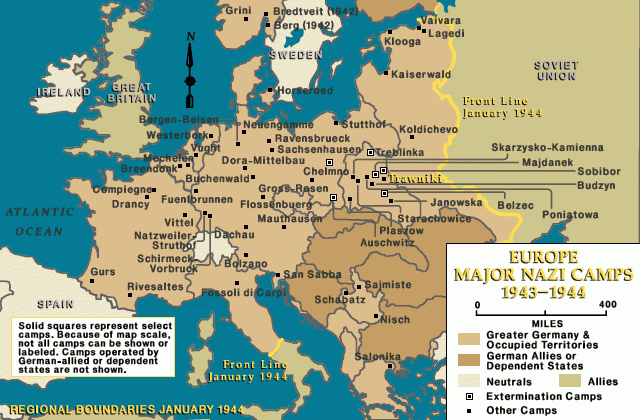
The "Trawniki Men"
SS and police officials inducted, processed, and trained 2,500 auxiliary police guards (Wachmänner, also known as Trawniki men) at Trawniki training camp between September 1941 and September 1942. Virtually all of them had been Soviet prisoners of war.
As German military reverses and the murderous treatment of the prisoners of war dried up the supply of suitable Soviet soldiers in the autumn of 1942, Streibel's men conscripted civilians. These civilians were primarily young Ukrainians, residing in Galicia, Wolhynia (Volhynia), Podolia, and the Lublin District. When Globocnik transferred out of Lublin in September 1943, he reported that 3,700 Wachmänner were serving in the Trawniki system. In fact, more than 4,750 identification numbers had been issued by this time.
Between 1941 and 1944, SS and police officials trained approximately 5,082 men at Trawniki. The Trawniki men were organized into two battalions under the command of SS Second Lieutenant Willi Franz and SS First Lieutenant Johann Schwarzenbacher.
Deployment in the operations of the "Final Solution" became a key function of the Trawniki-trained guards. The Trawniki men provided the guard units for the Operation Reinhard killing centers at Belzec, Sobibor, and Treblinka II. Companies of Trawniki-trained guards served for a time in the SS Death's-Head Units (SS-Totenkopfverbände) that guarded the concentration camps Lublin/Majdanek and Auschwitz. The Wachmänner also guarded forced-labor camps for Jews at Poniatowa, Budzyn, Treblinka I (the Treblinka labor camp), the Janow Street Camp in Lvov (L'viv), and other camps.
German SS and police authorities deployed the Trawniki men in deportation operations from both large and small ghettos in German-occupied Poland and as escorts for the transport trains from ghetto to killing center. Among the ghettos in which Trawniki-trained guards were deployed were Warsaw (three times), Czestochowa, Lublin, Lvov, Radom, Krakow, and Bialystok (twice).
Globocnik's recommendation for Streibel's promotion reflected the satisfaction of the SS leadership at how diligently the Wachmänner implemented their hideous tasks: Globocnik wrote that Streibel had commanded the Trawniki training camp
“with the greatest discretion and understanding for the special leadership needs of this unit. These units have proved themselves in the best way in many anti-partisan missions, but especially in the framework of the resettlement of the Jews.”
In 1942, Trawniki served as a transit camp for local Jews. After an early April “selection” of those incapable of work in the ghetto-town Piaski, located about six miles from Trawniki, Trawniki Wachmänner escorted several hundred Polish, German, and Austrian Jews from Piaski to Trawniki. Scheduled for deportation to the Belzec killing center the following day, many of the victims were locked up in a large barn-like structure overnight. Between 200 and 500 of the Jews died overnight from suffocation. Their bodies were tossed the next morning into the freight cars destined for Belzec.
During 1942, SS and police instructors also utilized the local Jewish population for “training purposes.” The new recruits received practical training in roundups and escort duty. Some zealous instructors reportedly ordered recruits individually to shoot a Jew.
Forced-Labor Camp
During the summer of 1942, Trawniki also began to serve as a forced-labor camp for Jews (Zwangsarbeitslager für Juden). Under the auspices of Operation “Reinhard,” the SS and police constructed the labor camp adjacent to the training camp, separated only by the original stone wall that surrounded the abandoned sugar factory.
The appearance of a Jewish workforce at Trawniki coincided with the establishment of procedures for disposing of the property of the Jews murdered in Operation Reinhard. Globocnik selected Trawniki to be a storage depot for clothing flowing in from the killing centers. The so-called Clothing Depot (Bekleidungslager) was located just outside the fence of the training camp. In June 1942, three freight cars stocked with baggage taken from Viennese Jews bound for Sobibor were diverted to Trawniki. That same month the SS brought in a Jewish labor detachment of 20 to 40 women to sort, wash, and repair the clothing.
As his SS and police murdered the last of those Jews in the General Government considered “incapable of work,” SS chief Heinrich Himmler grew increasingly fearful of resistance, yet was hopeful that the SS could better integrate the surviving Jewish forced laborers into the German armaments production process. On October 9, 1942, he ordered the transfer of all privately owned factories producing armaments and related goods, along with their Jewish forced laborers, from ghettos in the General Government to forced-labor camps, including Trawniki, where the Jews could be more easily guarded. In the late autumn of 1942, SS authorities moved a brush factory and its laborers from the Miedzyrzec-Podlaski ghetto, which the SS and police had just liquidated, to Trawniki. On February 8, 1943, Globocnik signed a contract with Fritz Emil Schultz of F.W. Schultz and Co.
The Schultz firm produced mattresses and furs, and repaired boots and uniforms. The contract provided that the Schultz fur production plant with its 4,000 Jewish workers and a brush-making plant with 1,500 more workers be transferred with all movable equipment and civilian personnel from the Warsaw ghetto to Trawniki. It named Streibel commander of the Trawniki labor camp with responsibility for distribution of labor, collection of fees for the forced laborers (five zlotys a day for men and four zlotys a day for women), and security. Day-to-day management of the camp, however, was the duty of SS Master Sergeant Franz Bartetzko and his deputy, SS Staff Sergeant Josef Napieralla. To manage the provision of forced laborers to the Schultz firm and to other firms located at other labor camps, the SS leadership founded a holding company, Ostindustrie GmbH (East Industries, Ltd.; Osti) on March 12, 1943.
Initially, the SS encouraged the Jews who worked in the Schultz plant to relocate voluntarily. On February 16, 1943, transports began to leave the Warsaw ghetto for Trawniki. Despite threats to shoot those who ignored SS incentives, Schultz could only persuade 448 out of 1,500 workers scheduled for transfer by April 14 to board the trains. Losing patience, the SS decided to liquidate the Warsaw ghetto. At 3:00 a.m. on the morning of April 19, 1943, SS and police units, including a battalion of 350 Trawniki-trained guards, sealed off the ghetto, sparking the Warsaw ghetto uprising. Between February 15 and April 30, 1943, 2,848 men, 2,397 women, and 388 children were removed from Warsaw to Trawniki in 17 transports via truck and train.
By May 1, at least 5,633 Jews resided in the Trawniki labor camp. Most of them were Polish Jews, but some were German, Austrian, and Slovak Jews. Between May 27 and July 24, eight new barracks were constructed to accommodate the influx of prisoners. Barracks construction continued until September 1943. The number of prisoners who worked for the Schultz concern at Trawniki hovered around 6,000 from May 1943 until the liquidation of the camp in November. Small detachments of prisoners worked directly for the SS in barracks construction and general camp maintenance. Two transports of Jewish workers arrived in Trawniki from the Minsk ghetto after its liquidation in September 1943.
In the interests of heightened production, Bartetzko initially maintained relatively decent conditions in Trawniki. He reportedly tolerated illicit trade in food and alcohol, permitted Jewish prisoners to form their own musical band, and even offered opportunities to play soccer. After August 1943, however, conditions deteriorated. Medical care after August was nonexistent and fear of sickness was endemic. Though the weather became cold in October, the workers received no winter clothing. Violations of camp regulations, such as theft or an attempt to escape, brought swift and brutal retribution.
One day in May or June 1943, Bartetzko shot a prisoner for attempting to escape. As a deterrent, the body was left where it fell for 24 hours. When three Jews were caught stealing equipment, Bartetzko assembled all available guards, prisoners, and Schultz firm executives to watch each of the three prisoners receive 25 lashes with a bullwhip. Frequent violators risked transfer to a subcamp located at Dorohucza, about two miles north of Trawniki. Under command of SS Sergeant Robert Jührs, Dorohucza's "industry" was digging peat—dangerous and difficult work for approximately 100 ill-clothed, ill-fed, and ill-equipped prisoners.
Subcamp of Lublin/Majdanek
For a variety of reasons, including Globocnik's quarrels with the civilian District Governor in Lublin and Osti's failure to secure Wehrmacht contracts, the SS leadership transferred the Trawniki complex to the jurisdiction of the SS Economic-Administration Main Office (SS-Wirtschafts-Verwaltungshauptamt; WVHA) in September 1943. Trawniki thus became a subcamp of Lublin/Majdanek. In the following months, 1,000 Trawniki-trained guards were transferred to Death's-Head battalions guarding concentration camps in the Reich, while 150 guards from the SS Death's-Head guards arrived in Trawniki.
Operation "Harvest Festival"
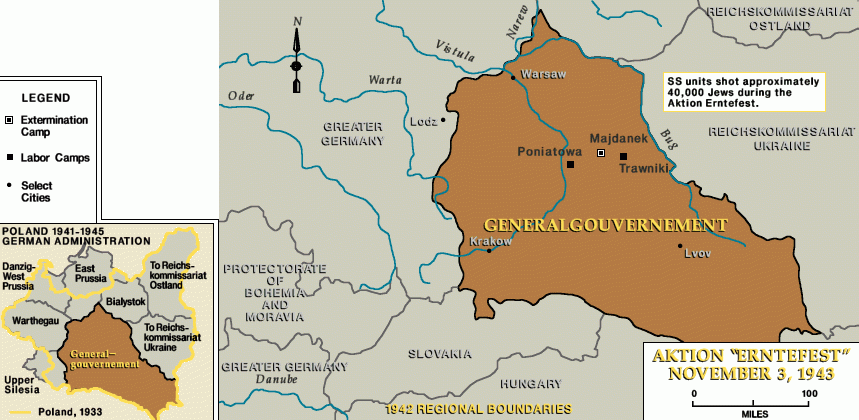
Stunned by the prisoner uprising in the Sobibor killing center, Himmler ordered the murder of the remaining Polish Jews in the Lublin District in late October 1943. As part of the cynically christened Operation “Harvest Festival” (Unternehmen Erntefest), SS and police units shot at least 6,000 Jewish inmates of Trawniki and Dorohucza on November 3, 1943, eliminating virtually the entire workforce. After the massacre, the Trawniki SS and police staff imported a small detachment of Jewish laborers from Milejow to burn the corpses on massive grills made from rail track, and then to disperse the ashes and bone fragments into trenches, which they covered with dirt. After completing this dreadful work, the Jewish laborers were shot and their bodies burned.
For weeks after the massacre, Trawniki-trained guards searched the camp grounds for hidden Jews. Those who were found within the first few weeks were shot. Zina Czapnik and her niece, Raja Mileczina, were able to hide for nearly two months before the Wachmänner discovered them. To Czapnik's astonishment, both women were permitted to live. They joined a detachment of approximately 40 Jewish women of Austrian and Dutch origin who had been brought to Trawniki after the massacre to perform domestic tasks inside the camp complex, such as laundry and cleaning the barracks for the SS staff and the Wachmänner. They also sorted and recycled Operation Reinhard booty and the clothing of the recently murdered Trawniki inmates. In May 1944, the SS transferred this small detachment to Lublin/Majdanek and the Trawniki labor camp was dissolved.
The Wachmänner continued to train at Trawniki until late July 1944, when the rapid Soviet advance forced the Germans to abandon Trawniki and Lublin itself. On July 23, 1944, Soviet troops overran both Trawniki and Lublin. The remaining Wachmänner, numbering around 1,000 men, fled in chaos to regroup west of the Vistula River.
Proceedings against Trawniki Officials
Some key officials at Trawniki did not survive the war or its immediate aftermath. Globocnik committed suicide upon capture by the British in Carinthia on May 31, 1945. Höfle was arrested by Austrian authorities in 1961 and committed suicide in his cell on August 21, 1962. Neither Trawniki battalion commander survived the war: SS Second Lieutenant Willi Franz went missing on July 31, 1944. SS First Lieutenant Schwarzenbacher was killed by partisans near Trieste on June 2, 1944. Bartetzko was killed at the front in January 1945.
Other Trawniki officials faced prosecution in the postwar decades. A West German court in Hamburg indicted Streibel, Napieralla, and four Trawniki company commanders in 1970, but acquitted all six defendants in 1976. Soviet military tribunals or Soviet civilian courts prosecuted hundreds, possibly as many as a thousand, of Trawniki-trained guards after the war: virtually all were convicted, some were executed. A handful of Trawniki-trained guards were tried in the West. A German court in Düsseldorf sentenced Franz Swidersky, a Treblinka labor camp guard, to life imprisonment in 1971.
The United States initiated successful denaturalization proceedings against 16 former Trawniki guards, including three who served at killing centers, and virtually all of whom guarded Jewish prisoners at Trawniki itself.
Critical Thinking Questions
- Learn about how the role of the Trawniki camp was uncovered and efforts to prosecute Trawniki officials and guards.
- To what degree was the local population aware of this camp, its purpose, and the conditions within? How would you begin to research this question?


